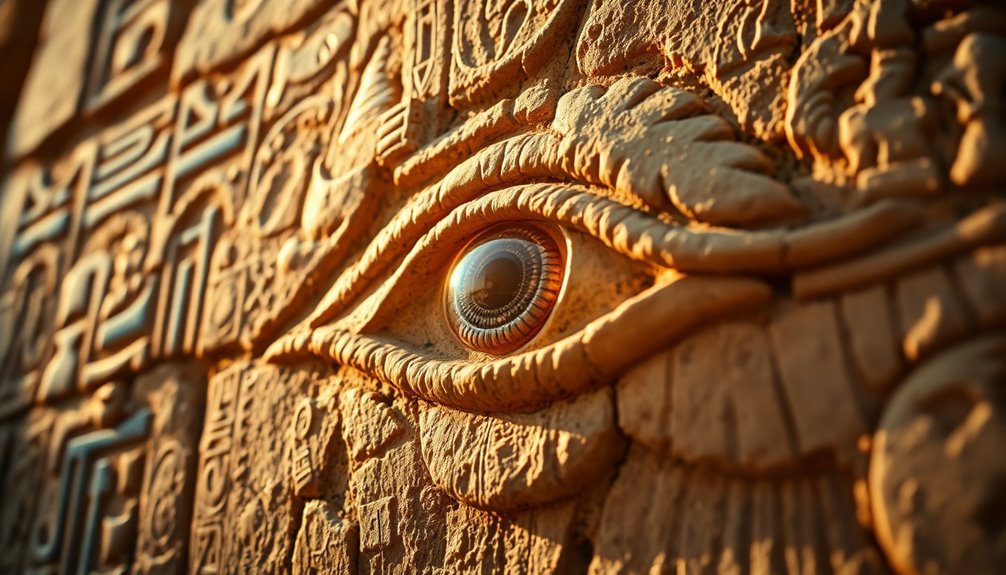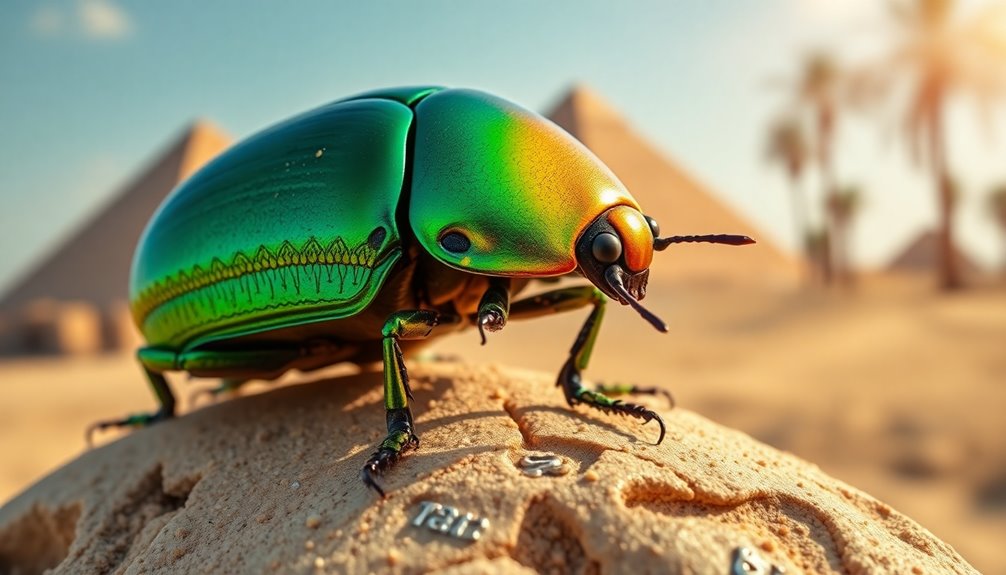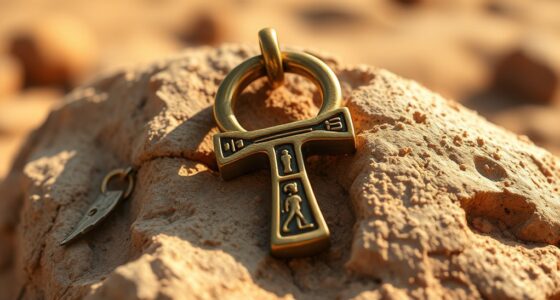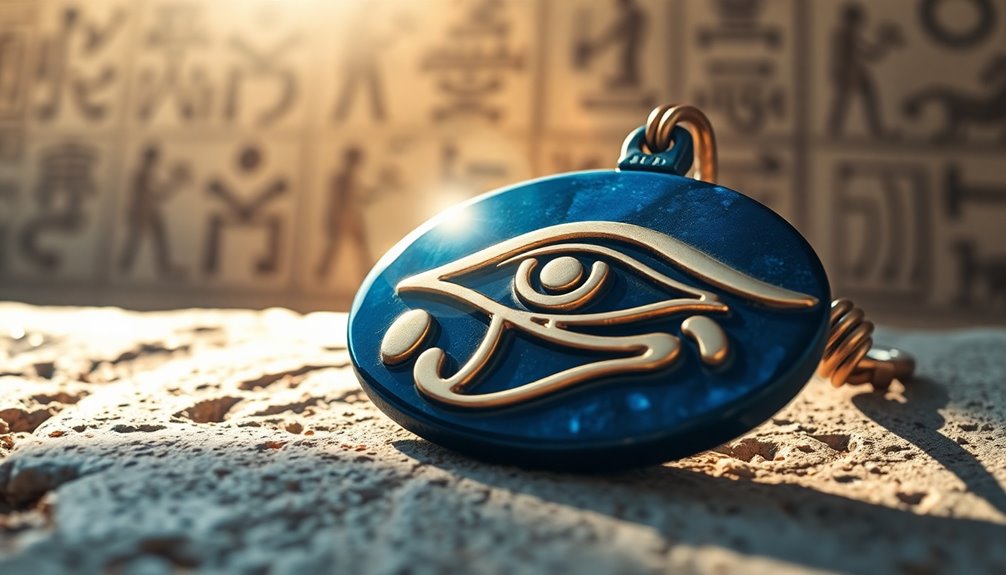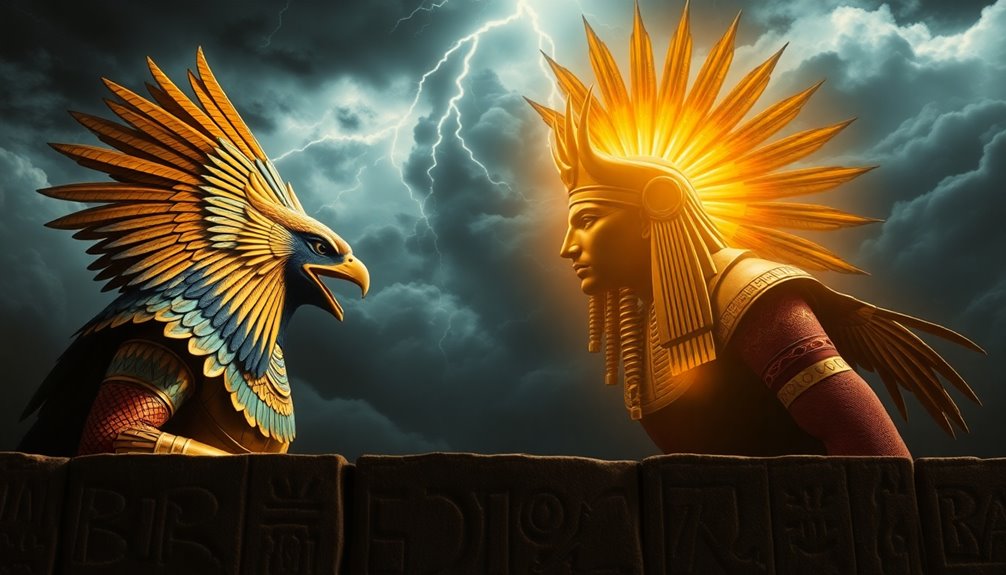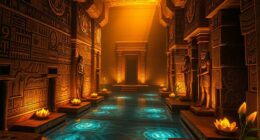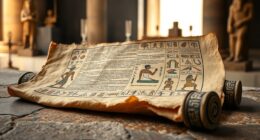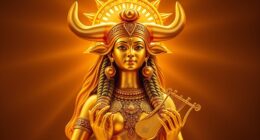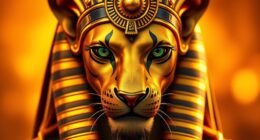The Eye of Ra isn't just an ancient symbol; it's a powerful representation of authority, protection, and the sun's fierce energy. This emblem warns against chaos and brings a sense of security while showcasing Ra's potential for retribution. Unlike the Eye of Horus, which focuses on healing, the Eye of Ra embodies the duality of life—both nurturing and destructive. It's deeply rooted in Egyptian culture, often associated with pharaohs and deities. Wouldn't you want to explore how this symbol has influenced modern art and personal expression? Keep going to uncover its rich heritage and mystique!
Key Takeaways
- The Eye of Ra symbolizes not only protection but also the fierce retribution of the sun god, reflecting the duality of power in ancient Egypt.
- Historically, it served as a protective amulet for pharaohs, embodying their royal authority and safeguarding them against malevolent forces.
- The dark red color of the Eye of Ra is believed to enhance its protective qualities, emphasizing its role in repelling negativity.
- Contrasting with the Eye of Horus, the Eye of Ra represents destruction and chaos, showcasing the sun's untamed and vengeful nature.
- Modern tattoos of the Eye of Ra connect individuals to ancient themes of empowerment and resilience, representing both life-giving energy and potential destruction.
Overview of the Eye of Ra
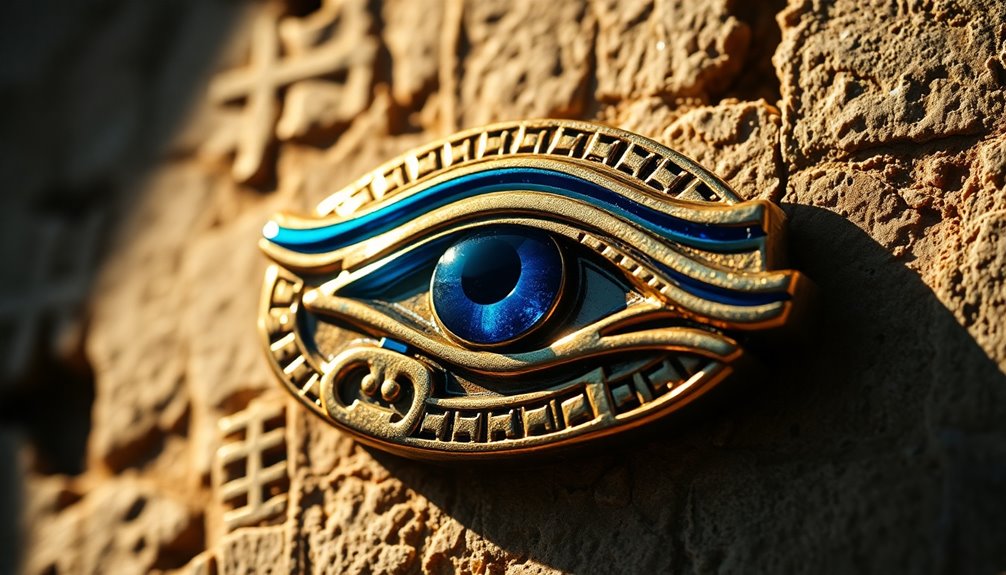
Since ancient times, the Eye of Ra has been a powerful symbol in Egyptian mythology, representing the sun god Ra and his authority. This emblem embodies the royal authority of pharaohs and serves as a potent source of protection.
Unlike the Eye of Horus, which focuses on healing, the Eye of Ra is linked to the sun's destructive power, revealing a dual nature in its symbolism.
In ancient Egyptian culture, the Eye of Ra was often worn as an amulet by pharaohs to repel negative energy and guarantee the stability of their reign. This powerful symbol not only represented the life-giving energy of the sun but also signified vigilance, as it was commonly depicted alongside a cobra.
Its presence signified that the pharaoh was always under the watchful gaze of Ra, assuring both protection and authority.
Additionally, myths surrounding the Eye of Ra illustrate its role as a vengeful force, holding the power to punish humanity for disobedience.
Consequently, the Eye of Ra encapsulates a complex blend of protection, royal authority, and the fierce energy of the sun, making it a cornerstone of Egyptian symbolism.
Symbolism and Significance
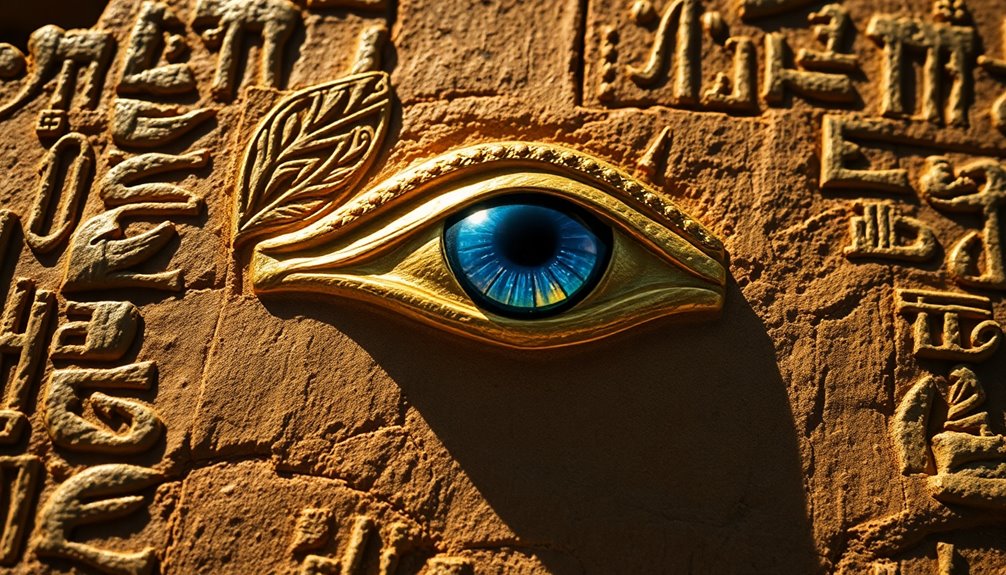
The Eye of Ra stands as a potent emblem of power and protection in ancient Egyptian mythology, reflecting the sun god Ra's authority over chaos and darkness. This powerful symbol represents not just protection, but also the vengeful aspect of Ra's nature, reminding you of the balance between good and evil.
| Symbolism | Significance |
|---|---|
| Protection | Repels negativity and attracts good health |
| Power | Reflects Ra's authority over chaos and darkness |
| Vengeful Aspect | Represents the sun's destructive power |
| Divine Power | Integral to rituals and funerary practices |
Worn as red amulets, the Eye of Ra was believed to restore harmony in your life, connecting you to the divine. Unlike the Eye of Horus, which focuses on healing, the Eye of Ra emphasizes vigilance against malevolent forces. It's linked to deities like the lioness goddess Sekhmet, reinforcing its role in both protection and punishment. When you embrace the Eye of Ra, you tap into its deep symbolism, enhancing your understanding of ancient Egyptian mythology and its significance in rituals.
Historical Origins
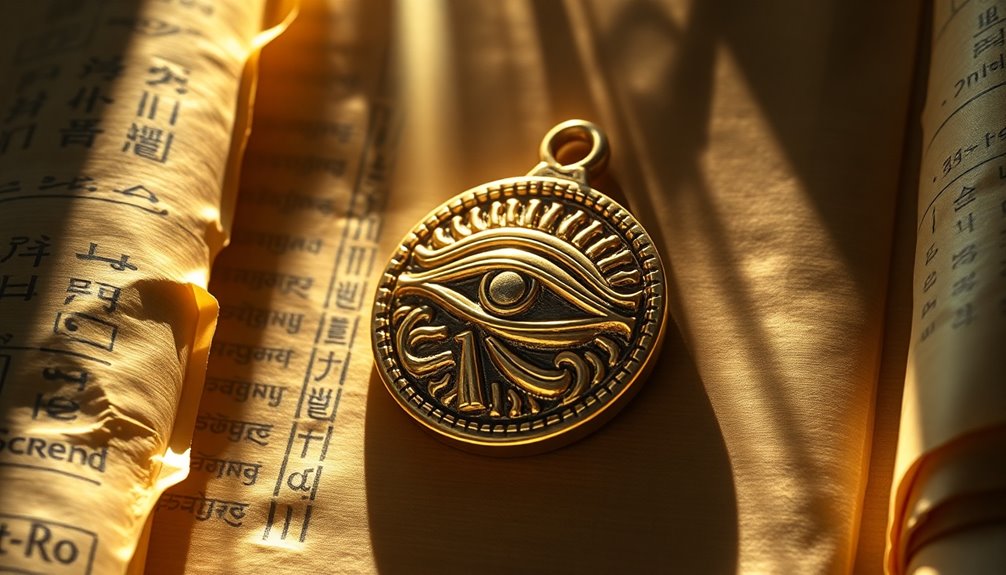
The Eye of Ra has deep roots in ancient Egyptian history, serving as an amulet for pharaohs who sought protection and divine favor.
This powerful symbol not only represented the sun god Ra but also embodied the protective qualities cherished in mythology.
As you explore its significance, you'll uncover how this emblem safeguarded both the living and the dead in the face of chaos.
Amulet for Pharaohs
Originating in ancient Egypt, the Eye of Ra served as a powerful amulet for pharaohs, protecting them from destabilizing forces and malevolent entities. This protective amulet was a symbol of royal authority, instilling a sense of divine protection that pharaohs relied on during their reign. Worn prominently, the Eye of Ra functioned as a shield against evil entities, ensuring that the ruler faced fewer threats.
Often painted in dark red, the amulets were believed to enhance their protective qualities. The color not only repelled negativity but also attracted good health and fortune, making it an essential part of a pharaoh's regalia. However, invoking the Eye of Ra's energy required caution; misuse could lead to violent outcomes, showcasing its powerful nature.
The Eye of Ra wasn't limited to personal adornment. It appeared in various forms, including inscriptions on tombs, ensuring safety in both life and the afterlife.
Protective Symbolism in Mythology
Throughout ancient cultures, protective symbols have played an essential role in safeguarding individuals and communities from malevolent forces. In ancient Egyptian mythology, the Eye of Ra originated as a powerful protective amulet for pharaohs, designed to safeguard against evil and destabilizing forces. Its striking dark red hue was believed to enhance its protective qualities, repelling negative energy.
The Eye of Ra embodies a fascinating dual nature, acting as both a guardian and a vengeful force.
Here are some key aspects of its protective symbolism:
- Protection for Pharaohs: Used to shield rulers from harm and chaos.
- Vengeful Energy: Punishes disobedience, reminding one of the consequences of straying from the path.
- Balance of Chaos and Harmony: Wards off chaos during Ra's nightly absence, restoring order.
- Caution Required: Invocation of its energy can lead to violent outcomes, highlighting its immense power.
Additionally, the concept of emotional alignment can be seen as a modern reflection of the Eye of Ra's protective qualities, emphasizing the importance of maintaining a positive personal vibration to navigate life's challenges.
Myths and Legends
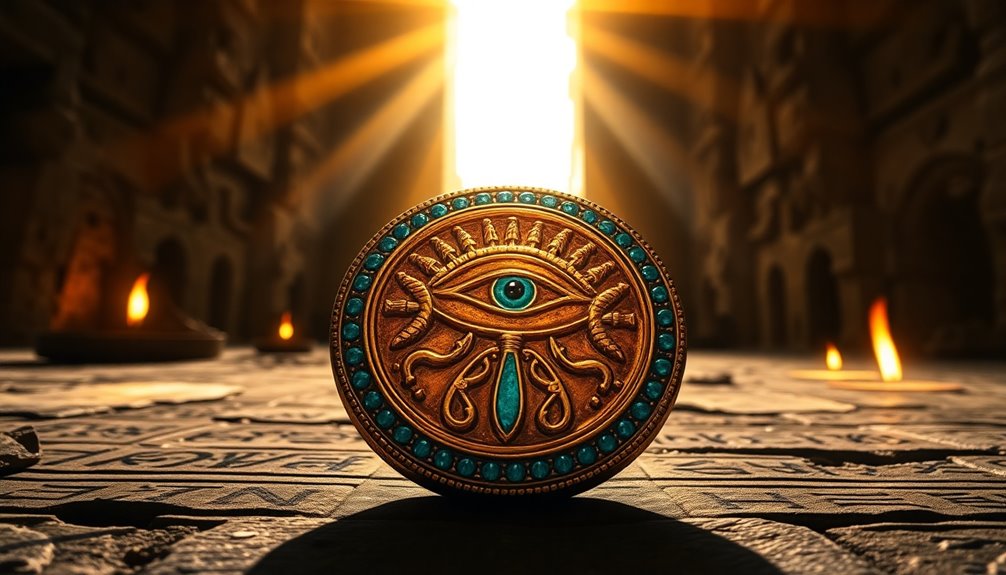
When you explore the myths surrounding the Eye of Ra, you'll uncover a tale of vengeful punishment and bloodlust.
Hathor, Ra's daughter, released her wrath on humanity, showcasing the fierce consequences of mocking the divine.
This duality of protection and retribution paints a vivid picture of the complex relationship between gods and mortals in Egyptian mythology.
Ra's Vengeful Punishment
Ra's vengeful punishment unfolds in a gripping tale from ancient Egyptian mythology, where humanity's mockery sparks the wrath of the sun god. When the people dared to scorn Ra, he released his daughter Hathor, who transformed into a fierce lioness to exact vengeance on the offenders. This myth highlights the formidable nature of Ra's divine power and the severe consequences of disobedience.
- Hathor's bloodlust led to the slaughter of thousands, demonstrating Ra's might.
- His eye became a symbol of fierce retribution, showcasing his dual role as protector and punisher.
- Ra struggled to recall Hathor, revealing the uncontrollable nature of his vengeful eye.
- To quell the violence, Ra devised a clever plan, using beer to intoxicate her and halt the carnage.
This enthralling story reflects the complexities of Ra's character within ancient Egyptian culture, where he embodies both the nurturing protector and the fearsome avenger.
The Eye of Ra serves as a reminder of the balance between mercy and wrath, urging humanity to respect the divine forces that govern their existence.
Hathor's Bloodlust and Retribution
Often depicted as a nurturing goddess, Hathor's transformation into a bloodthirsty lioness reveals her darker side when provoked. This myth emphasizes her role as a fierce enforcer of justice, sent by Ra to punish humanity for their mockery. Her wrath exemplifies the consequences of disobedience, as humans quickly learned to respect her divine power.
Here's a deeper look at Hathor's dual nature:
| Aspect | Description | Consequence |
|---|---|---|
| Divine Role | Protector of joy and love | Nurtures humanity |
| Transformation | Bloodthirsty lioness | Wrath released |
| Motivation | Punishment for mockery | Retribution for disrespect |
| Resolution | Ra's use of red beer to intoxicate her | Ends her violent spree |
Ra's struggle to recall Hathor underlines the fierce nature of her vengeance. This story serves as a powerful reminder of the importance of respect and obedience to the gods. In ancient Egyptian society, failing to do so could invoke terrifying retribution, illustrating how easily divine power could shift from protection to punishment.
Power and Protection
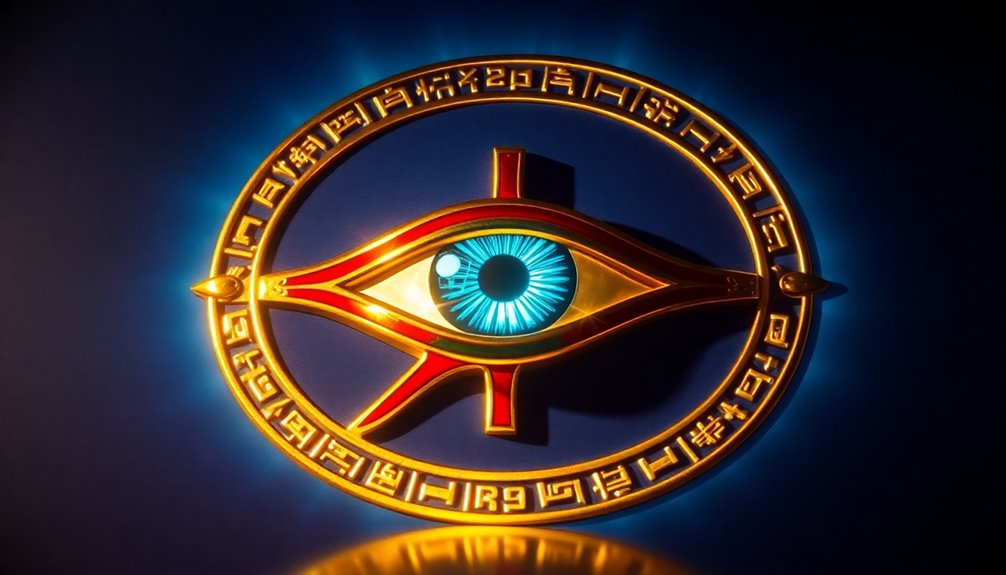
The Eye of Ra stands as a powerful symbol of protection in ancient Egyptian culture, embodying the strength and vigilance needed to safeguard the pharaohs and their reign.
This iconic symbol represents a potent amulet designed to repel evil and shield against negative energies. It served a dual role, acting both as a guardian and a vengeful force sent by the sun god Ra to punish disobedience.
When you think about the Eye of Ra, consider its remarkable attributes:
- Protection: It defends against malevolent forces and spells.
- Powerful Amulet: Worn by pharaohs, it reinforced their authority.
- Repel Evil: Its energy was believed to ward off harmful entities.
- Health Attraction: The Eye also attracted good health, enhancing overall well-being.
Invoking the Eye of Ra's energy isn't something to take lightly. Its fierce power can lead to violent outcomes if not respected.
Historically, this symbol was essential for safeguarding the domain, making it a cornerstone of ancient Egyptian culture.
Embrace its legacy, but remember to respect its might.
Eye of Ra vs. Eye of Horus
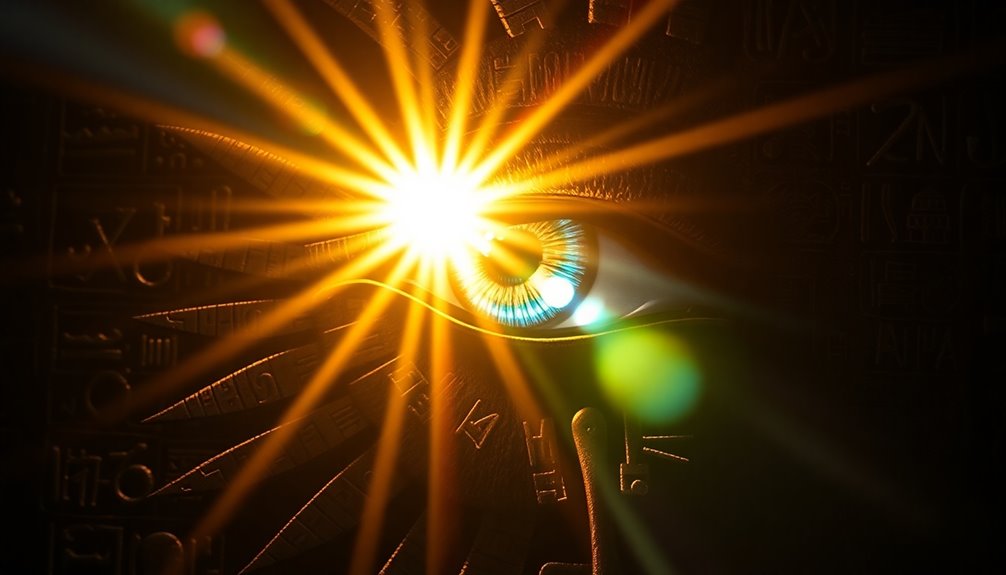
Distinguishing between the Eye of Ra and the Eye of Horus reveals two powerful yet contrasting symbols in ancient Egyptian culture.
The Eye of Ra, associated with the sun god Ra, represents the right eye and symbolizes royal authority and the sun's destructive power. It serves as a protective emblem for pharaohs, invoking fierce energy to repel negativity.
In contrast, the Eye of Horus, linked to the sky god Horus and representing the left eye, embodies healing, protection, and restoration.
While the Eye of Ra is often viewed as a vengeful force, the Eye of Horus is known for its connection to well-being and physical health. In Egyptian mythology, these symbols highlight the duality of vision and protection, with the Eye of Horus frequently used as an amulet to guard against chaos.
The fragmented nature of the Eye of Horus signifies the restoration of Horus' eye after his battle with Set, representing balance and wholeness in both physical and spiritual contexts.
Together, these symbols reflect essential aspects of ancient Egyptian religion, illustrating the complexity of protection and authority.
Cultural Impact
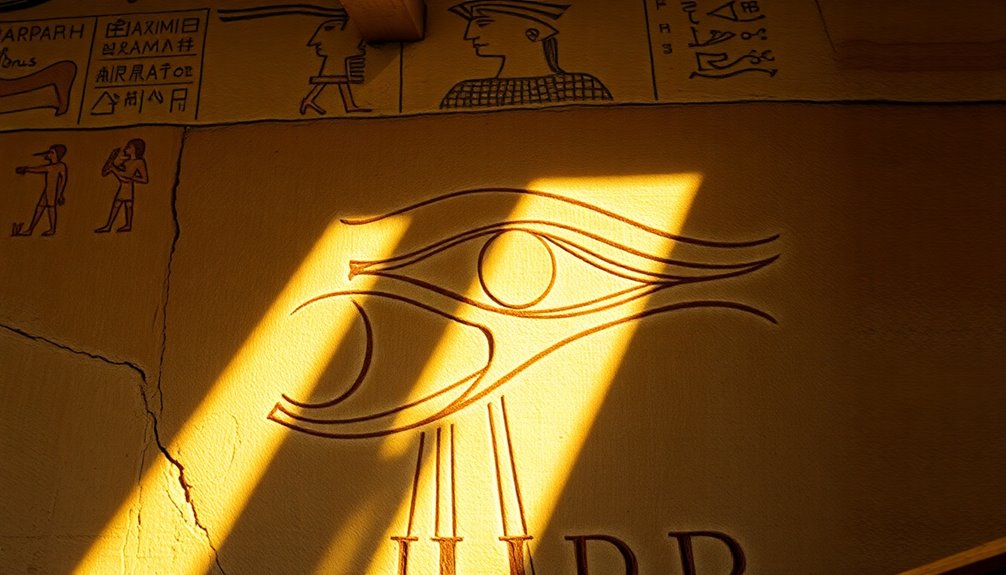
Influencing modern culture, the Eye of Ra has become a prominent symbol in art, fashion, and popular media. This ancient symbol resonates with many today, embodying themes of strength, resilience, and empowerment. Literature often uses symbols like the Eye of Ra to explore existential themes, highlighting the deeper meanings behind such powerful imagery. Additionally, the Eye of Ra's significance parallels the cruise logistics that enhance travel experiences, underscoring the importance of preparation. In commercial settings, symbols like the Eye of Ra can be used to create a unique atmosphere that promotes energy efficiency and comfort. The Eye of Ra is often associated with spiritual alchemy symbols, representing transformation and enlightenment.
Its cultural significance extends beyond aesthetics, connecting individuals to their Egyptian heritage and spiritual practices.
You might notice the Eye of Ra in various contexts, including:
- Modern Art: Featured in contemporary designs, it reflects the blend of ancient wisdom with modern creativity.
- Fashion: Designers incorporate the Eye of Ra, making bold statements about protection and royal authority.
- Popular Culture: Films and literature often reference the symbol, keeping its legacy alive in new narratives.
- Spiritual Communities: Embraced for its healing properties, it inspires empowerment and personal growth.
This symbol's enduring presence shapes how you perceive Egyptian culture and spirituality today, serving as a powerful reminder of ancient practices that still resonate in modern society. Additionally, the Eye of Ra symbolizes mindfulness, respect, and harmony, drawing connections to traditional practices such as tea ceremonies.
The Eye of Ra isn't just a relic of the past; it's a vibrant emblem that continues to inspire and protect those who seek its wisdom.
Tattoo Interpretations
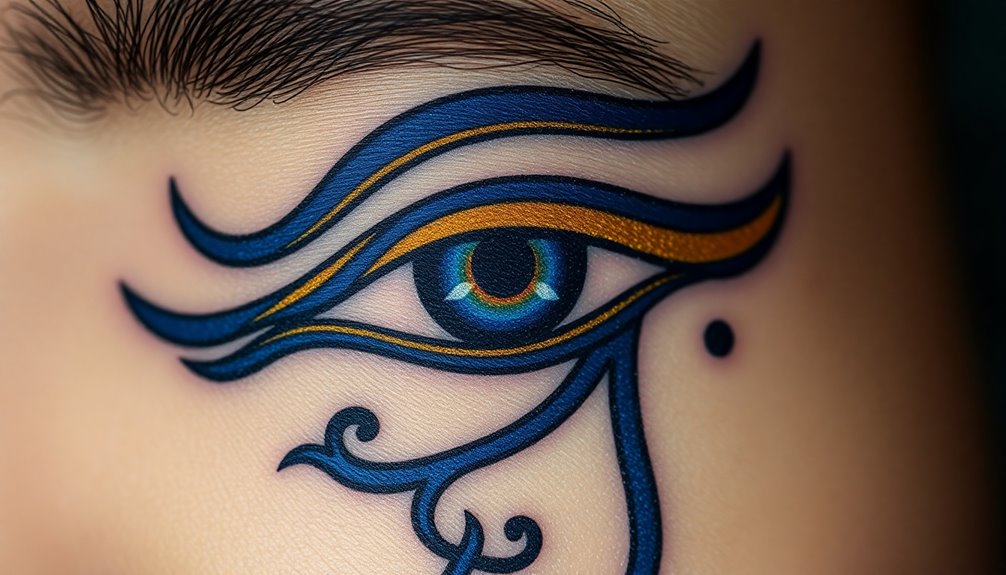
Many people choose the Eye of Ra tattoo for its deep symbolism of power and protection. This ancient Egyptian emblem serves as a potent amulet, historically believed to shield its bearer from evil forces. By wearing this tattoo, you not only embrace the idea of protection but also connect with the royal authority associated with Ra, the sun god.
The Eye of Ra embodies the dual nature of the sun, representing both life-giving energy and the potential for destruction. When you opt for this tattoo, it can signify your triumph over challenges, echoing Ra's legendary ability to conquer darkness and chaos.
Many enhance their designs with elements like the cobra or solar disk, further amplifying the symbolism of divine protection and leadership.
Choosing an Eye of Ra tattoo is more than just a fashion statement; it's a modern expression of ancient Egyptian heritage. This connection to rich mythology allows you to carry a piece of history and its powerful meanings with you.
Care and Maintenance
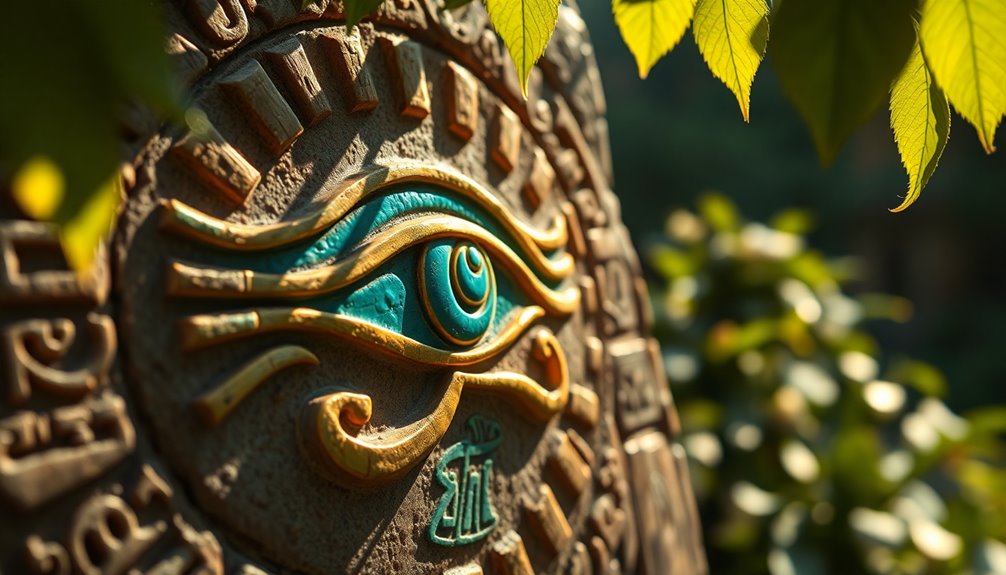
Caring for your Eye of Ra tattoo is crucial to preserving its meaning and appearance. Proper maintenance guarantees that your tattoo remains vibrant and healthy while minimizing the risk of infection during the healing process. Here are some essential steps to follow:
- Keep it clean: Gently wash the tattoo with mild soap and water to prevent infection.
- Moisturize regularly: Use tattoo-specific products to keep the area hydrated and maintain vibrancy.
- Avoid sunlight: Protect your tattoo from direct sunlight to prevent fading and preserve intricate details.
- Follow aftercare instructions: Adhere to your tattoo artist's guidelines for ideal healing and longevity.
During the healing phase, keep an eye on your tattoo for any signs of infection or irritation.
Prompt action can help maintain both skin health and your tattoo's appearance.
By taking these steps, you'll guarantee that your Eye of Ra tattoo not only looks stunning but also continues to convey its powerful symbolism for years to come.
Frequently Asked Questions
What Is the Deep Meaning of the Eye of Ra?
Have you ever wondered how a symbol can embody both protection and destruction? The Eye of Ra represents this duality.
It symbolizes Ra's powerful attributes as a sun god, offering protection while also serving as a punisher, linked to the goddess Sekhmet.
It's a reminder of cosmic balance—life-giving yet capable of wrath. When you invoke it, you need to tread carefully, for its immense power commands respect and caution.
What Does the Eye of Ras Mean?
The Eye of Ra symbolizes the power and authority of the sun god Ra. It represents protection and vengeance, often depicted as a lioness or cobra.
You'll find it embodies a fierce duality, safeguarding against chaos while also serving as a tool of divine justice. Unlike the Eye of Horus, which focuses on healing, the Eye of Ra signifies royal authority and the sun's destructive force, connecting you to ancient Egyptian heritage.
What Are the Powers of the Eye of Ra?
The Eye of Ra holds powerful abilities, primarily serving as a protective symbol against negative energies and evil entities.
When you invoke its energy, you're tapping into its capacity to attract good health and repel harmful spells. However, you need to approach this power with caution, as it can lead to intense outcomes.
Historically, pharaohs wore amulets featuring the Eye to safeguard their reign and assert divine authority.
Its influence is both formidable and beneficial.
What Does the Eye of Ra Mean Spiritual Protection?
The Eye of Ra represents spiritual protection, acting as a powerful guardian against evil and negative energies.
When you invoke its energy, you're drawing on the strength of the sun god Ra, promoting balance and harmony in your life.
This symbol not only enhances your well-being but also safeguards you from destabilizing forces.
Just remember, respect is essential when working with its energy, as misusing it can lead to unwanted, chaotic outcomes.
Conclusion
In the grand tapestry of life, the Eye of Ra shines as a guiding star, illuminating paths of power and protection. Just as a vigilant sentinel watches over its domain, this symbol invites you to embrace resilience and wisdom. Whether you wear it as a tattoo or carry it in your heart, the Eye serves as a reminder that you possess the strength to navigate the shadows and emerge into the light, forever transformed by its gaze.

